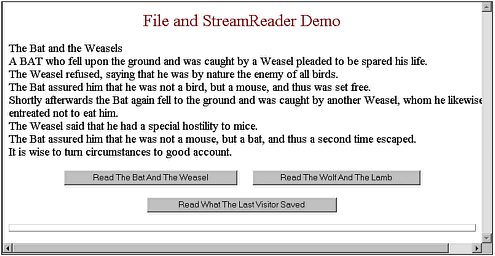The File and StreamReader Classes
The File and StreamReader ClassesThe Directory class offers a lot to developers. Now that we've covered that, we'll move on to another important class. The File class aids in the creation of FileStream objects and provides routines for the creation, copying, deletion, moving, and opening of files. The StreamReader class implements a TextReader that reads characters from a byte stream in a particular encoding. StreamReader is designed for character input in a particular encoding, whereas the Stream class is designed for byte input and output. StreamReader defaults to UTF-8 encoding, rather than the ANSI code page for the current system, unless specified otherwise . UTF-8 handles Unicode characters correctly and gives consistent results on localized versions of the operating system. This section examines reading (or opening) files from disk and displaying their contents to users. Of course, there are plenty of other reasons to read from disk, but this gets you started with easy-to-understand examples. Opening a FileThe first thing you must do to read data from a file is open it. The File class's OpenText() method is used in the examples that come later in this section. This method returns a StreamReader class, which can then be used to read the data in. The following code shows how to open a file using the File.OpenText() method: Dim reader as StreamReader Dim strFilename as String strFilename = "C:\Temp\Dir\Data.txt" reader = File.OpenText( strFilename ) Reading DataAs mentioned earlier, the StreamReader class provides an easy way to read data from a disk file. The two methods used in the following examples are Peek() and ReadLine() . The Peek() method returns a -1 if no more data is left to read. The ReadLine() method returns the next line from the text file. The following code shows how to use an already opened StreamReader object to read all the lines of a text file: While reader.Peek() <> -1 StrAllData = strAllData + reader.ReadLine() End While Figure 5.8 shows a sample application that reads and displays one of two text files (The Bat and the Weasel or The Wolf and the Lamb). If you click on the button labeled Read The Bat and the Weasel, the text from that fable will be displayed. If you click on the button labeled Read The Wolf and the Lamb, the text from that fable will be displayed. If you click on the Read What the Last Visitor Said button, the text that the last visitor entered will be displayed. This example can be found on the book's Web site at http://www.usingasp.net/SysIO/file.aspx. Listing 5.8 shows the code that responds to the button clicks and loads and displays the text data. Figure 5.8. The File and StreamReader classes make reading text files easy. Listing 5.8 Using Two Methods to Provide the Functionality that Loads and Displays Text Files Private Sub Button1_Click(ByVal sender As System.Object, ByVal e As System.EventArgs) _ Handles Button1.Click Dim reader As StreamReader Try Label1.Text = "" reader = file.OpenText(Request.MapPath("BatAndWeasel.txt")) While reader.Peek() <> -1 Label1.Text = Label1.Text + reader.ReadLine() + "<br>" + vbCrLf End While Catch ex As Exception Label1.Text = ex.Message End Try End Sub Private Sub Button2_Click(ByVal sender As System.Object, ByVal e As System.EventArgs) _ Handles Button2.Click Dim reader As StreamReader Try Label1.Text = "" reader = File.OpenText(Request.MapPath("WolfAndLamb.txt")) While reader.Peek() <> -1 Label1.Text = Label1.Text + reader.ReadLine() + "<br>" + vbCrLf End While Catch ex As Exception Label1.Text = ex.Message End Try End Sub Visitor CommentsI created a third button for the preceding example. When it's clicked, the application loads a text file named MessageText.txt. This text file is written in an example that comes later in this chapter. It enables users to write a comment for other users to read. The code can be seen in Listing 5.9. Listing 5.9 Loading the MessageText.txt File That Is Saved by Visiting Users Sub Button3_Click(ByVal sender As System.Object, ByVal e As System.EventArgs) Dim reader As StreamReader Try label1.Text = "" reader = File.OpenText(Request.MapPath("VisitorFiles\MessageText.txt")) Dim strTemp As String strTemp = reader.ReadToEnd() strTemp = Replace(strTemp, Chr(13) + Chr(10), _ "<br>" + Chr(13) + Chr(10)) label1.Text = strTemp reader.Close() Catch ex As Exception label1.Text = ex.Message End Try End Sub |
EAN: 2147483647
Pages: 233
